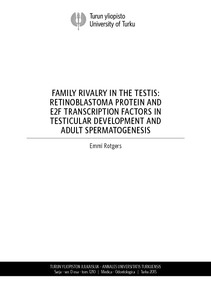Family rivalry in the testis: Retinoblastoma protein and E2F transcription factors in testicular development and adult spermatogenesis
Rotgers, Emmi (2015-12-11)
Family rivalry in the testis: Retinoblastoma protein and E2F transcription factors in testicular development and adult spermatogenesis
Rotgers, Emmi
(11.12.2015)
Annales Universitatis Turkuensis D 1210 Turun yliopisto
Julkaisun pysyvä osoite on:
https://urn.fi/URN:ISBN:978-951-29-6331-7
https://urn.fi/URN:ISBN:978-951-29-6331-7
Kuvaus
Siirretty Doriasta
ei tietoa saavutettavuudesta
ei tietoa saavutettavuudesta
Tiivistelmä
Disorders of male reproductive health are becoming increasingly prevalent globally. These defects, ranging from decreasing sperm counts to an increasing rate of infertility and testicular cancer, have a common origin in the early phases of testicular development, but the exact mechanisms that cause them remain unknown.
Testicular development and adult spermatogenesis are complex processes in which different cell types undergo mitosis, meiosis, differentiation and apoptosis. The retinoblastoma protein family and its associated E2F transcription factors are key regulators of these cellular events. In the present study, the functions of these factors in postnatal testicular development and adult spermatogenesis were explored using different animal models. In addition, a new application of flow cytometry to study testicular cell dynamics was developed.
An ablation of retinoblastoma protein in mouse Sertoli cells resulted in their cell cycle re-entry in adult testes, dedifferentiation and a severe spermatogenic defect. We showed that deregulated E2F3 contributed to these changes. Our results indicated that the E2F1 transcription factor is critical for the control of apoptosis in the developing postnatal testis. In the adult testis, E2F1 controls the maintenance of the spermatogonial stem cell pool, in addition to inhibiting apoptosis of spermatocytes.
In summary, this study elucidated the complex interdependencies of the RB and E2F transcription factor families in the control of postnatal testicular development and adult spermatogenesis. Furthermore, this study provided a new methodology for the analysis of testicular cells.
Testicular development and adult spermatogenesis are complex processes in which different cell types undergo mitosis, meiosis, differentiation and apoptosis. The retinoblastoma protein family and its associated E2F transcription factors are key regulators of these cellular events. In the present study, the functions of these factors in postnatal testicular development and adult spermatogenesis were explored using different animal models. In addition, a new application of flow cytometry to study testicular cell dynamics was developed.
An ablation of retinoblastoma protein in mouse Sertoli cells resulted in their cell cycle re-entry in adult testes, dedifferentiation and a severe spermatogenic defect. We showed that deregulated E2F3 contributed to these changes. Our results indicated that the E2F1 transcription factor is critical for the control of apoptosis in the developing postnatal testis. In the adult testis, E2F1 controls the maintenance of the spermatogonial stem cell pool, in addition to inhibiting apoptosis of spermatocytes.
In summary, this study elucidated the complex interdependencies of the RB and E2F transcription factor families in the control of postnatal testicular development and adult spermatogenesis. Furthermore, this study provided a new methodology for the analysis of testicular cells.
Kokoelmat
- Väitöskirjat [3056]
